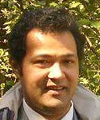Keynote Speakers
doi:10.3850/4M2009RP001_9008
Single-Crystal based Composite Wafers for High Quality Passive RF Microdevices

Sylvain Ballandras
FEMTO-ST, UMR CNRS-UFC-ENSMM-UTBM 6174,
Time-Frequency Department, Besançon, France
Biography
Sylvain Ballandras was born in Strasbourg in 1965. He joined the CNRS in 1991, after his PhD in Engineering Sciences from the UniversitÚ de Franche-ComtÚ. From 1991 to 1995, he has been working on surface acoustic wave (SAW) devices, but he was mainly involved in the development of micromachining technologies. He initiated the development of a finite element analysis package devoted to acoustic transducers and also new researches on miniaturized transducers for endoscopic applications. He joined TMX in 1997 for a one year industrial training project. From 1999 to 2005, he was responsible for the research group entitled « Acoustique et Microsonique » at LPMO. He created its own consulting office to answer specific demands from industry.
In October 2003, he was promoted Research Director at the CNRS, in the newly created FEMTO-ST Institute in Besanšon. In 2008, Sylvain Ballandras’ group joined the Time-Frequency Department of FEMTO for the purpose of scientific coherence and moved to Besançon’s national engineering school ENSMM. Its present scientific developments concern the fundamentals in acoustics and guided propagation, as well as technologies dedicated to acousto-electronic devices and systems, focused on sources, filters and sensors.
Sylvain Ballandras also benefitted from the 25.2 agreement of the French research rules to join as a member of senior staff of SENSeOR (a spin-off from TEMEX dedicated to SAW and BAW sensors) at the end of 2008.
Abstract
New guiding principles and concepts are currently investigated for developing high frequency devices capable to answer the RF manufacturer demand for telecommunication an remote transmission modern components. Beside the use of physically or chemically deposited piezoelectric overlays, the use of composite wafers composed by single crystal layers and wafers obtained by wafer bonding and lapping/polishing techniques offers attractive opportunities for overpassing the known limitations of acoustics-based radio-frequency devices. In this paper, we present different approaches for manufacturing such composite wafers and we describe different applications taking advantage of their unique characteristics. Lithium niobate is particularly considered for the piezoelectric layers because of its exceptional piezoelectric properties and its very high acoustic quality, and various substrate such as silicon, sapphire and lithium niobate again are used to guide and trap the excited waves. State-of-the-art Surface Acoustic Wave (SAW) devices, Harmonic Bulk Acoustic Resonators (HBARS) and Periodically Poled Transducers developed on such wafers are presented to illustrate the potential of this technological approach.

